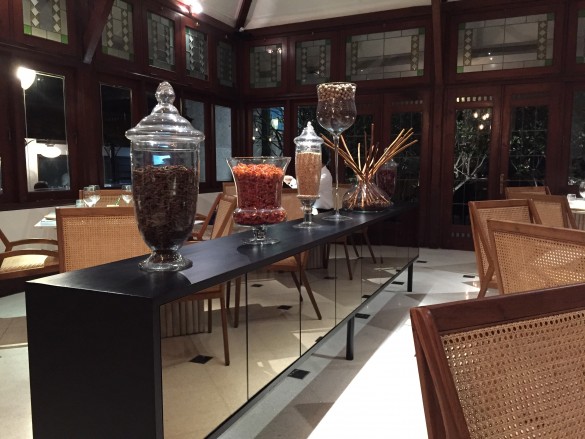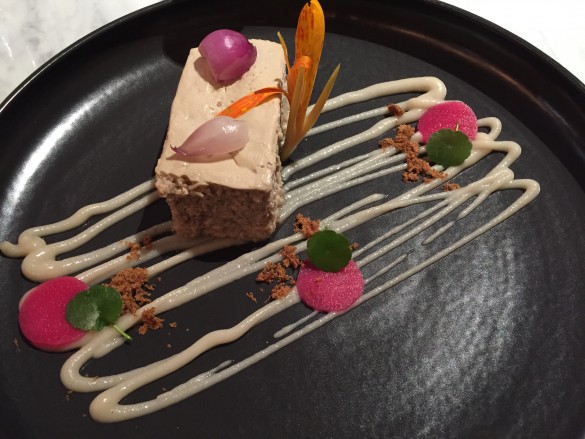Where modernity and tradition collide in a bountiful and elegant display of unique Indonesian ingredients and regional cuisine.
The challenges with modern gastronomy and the chefs who defy the traditional methods and cuisines are that most often they forget the fundamental elements of restaurant dining. The food has to taste good; ingredients should be celebrated (with importance placed on perceived value); and the dining experience has to remain cohesive with a narrative to bring the audience on board a journey, whatever it may be. Lose any of those elements, and you lose the essence of the dining experience, whether it is from a street stall or the highest echelons of fine dining.
As a critic, I’ve ridden the highs and lows of modernist cuisine. Nothing is more excruciating in this job than counting down the courses of a meal where there is little more than a chef’s ego presented on a plate. However, when it is done well, there is little comparison to the joy felt when a special connection is established between the chef’s masterful articulation of the cuisine and his guests. In some unique cases, a chef can change the course of an indigenous cuisine; much like what Juan Mari Arzak did for Basque/Spanish cookery or what Auguste Escoffier did for French cuisine.
Chef Ragil Imam Wibowo possesses a mastery of the unique Indonesian culinary heritage, and artfully conveys the complexity of Indonesian ingredients.
His food is steeped in tradition, but is also elegantly adapted to the modern palate, for Indonesians as well as those who have a little less literacy in the vast diversity that is traditional Indonesian cuisine.
That his creations can translate so well across different cultures is a testament to his talent in the kitchen.
Chef Ragil’s team could not be faulted, either. From the moment guests step in through the front doors of the historic Dutch Colonial building to the moment they leave, there is a real sense of hospitality and dedication to service. This was one of the only few times in my stay here in Jakarta when I have seen a veritable level of hospitality that is on par with international standards. Our server, a lovely young woman with an excellent command of not only English, but of the menu and ingredients, metaphorically held our hands through the impressive details of the menu. We were never for want, and clear cues from our dining table (without actually having to signal for staff) were attended to quickly. The timing and presentation were excellent, and the service was friendly without being intrusive.
As the restaurant is situated inside a historic home, there are many rooms to explore, and apparently, lounge in. The intertwining of rattan, grey marble table-tops, wooden chandeliers and onyx tableware could have felt fragmented and uninspired. However, every element was incorporated and presented in a harmonious nod to tradition and the modern Indonesian aesthetic, quietly buoying the meals presented and allowing them take centre stage. That the different design elements were also sourced from local, young artists is also exemplary of how far the chef’s vision extends to each area of his restaurant.
From the refreshing and effervescent jamu (welcome drink) to the final course of coffee and Indonesian-style petits fours, there is an emphasis on regional ingredients and flavour profiles. The kitchen prides itself on finding the best local producers and paying homage to the wonderful bounty that Indonesia has to offer. Evidently, some ingredients are not cultivated, but are harvested by indigenous communities in remote areas of the archipelago.
The amuse bouche plate featured four select bites, which are not for the squeamish, as one featured cow brains stewed in curry spices and another local eels dried cracker-crisp in the style of a grissini and dipped in a tomato-based sambal, which was good enough to drink in the style of gazpacho. The buffalo cheese had a texture reminiscent of that of fresh Italian buffalo mozzarella, but held a mellow funk more appropriate in Southeast Asia.
The gorgeous appetizers were presented in a burst of lovely pastels and spring colours: the Gohu Udang is the Northern Maluku version of a prawn ceviche, marinated in kalamansi lime juice and coconut milk and highlighted by a delicate dressing of sweet basil, sambal and edible flowers. The shaved and dried tuna salad was gloriously savoury with a hint of smoke and splash of lavender from the bunga telang, the butterfly pea flower that is a natural food dye commonly used in Southeast Asia. The visual appeal of the dish is only part of what makes it so wonderful; this is a dish I can rally well behind.
Another standout course was the Sop Ikan Kuah Kuning, red snapper with shaved fermented wood fish flakes, mini carambola and Thai sweet basil. The chef incorporated large balls of papeda, a type of chewy sago starch that is usually the base of a meal for Papuans. It provided an interesting counter to the fragrant, clear fish broth.
For the main course, the Ayam Lempah Kulat Pelawan is extraordinary. Although the slow-braised, free-range, local breed chicken was fine on its own, the addition of stewed pelawan mushrooms took it to another level. These delicate mushrooms are seasonal and rare, found growing only on the pelawan tree on Bangka Island in Sumatra. Its flavour is reminiscent of a mild dried porcini. Another favourite is the Gadon Rebung Daging. Ground local, free range, grass-fed Balinese beef is cooked in banana leaves to a custard-like consistency, and served with fresh bamboo shoots and a delicious creamy sauce that goes splendidly with the fluffy, Indonesian steamed rice.

There were only a few slight missteps throughout the evening. The Bacem Daging, a slow braised beef and vegetables main course arrived tough and chewy. Perhaps if the beef had another 30 minutes to an hour in the pot, it would have been fine. Unfortunately, the sinew and gristle was still present and the slices of beef were difficult to eat. The aforementioned cow brain amuse bouche was served lukewarm and tasted surprisingly bland even with curry spices, and had it been more than a bite, I don’t think I would have been able to stomach it.
The desserts were excellent, and spoke to an understated and delicate pastry chef, whose muted voice could still stand on its own against the former half of the meal. Vision and creativity, along with traditional French techniques and amazing local spices, fruits and seasonings leant to a powerful finish.
4 Stars
NUSA Indonesian Gastronomy
Jalan Kemang Raya 81
Kemang, Jakarta 12730
Telephone: 021-719-3954
Email: journey@nusagastronomy.com





